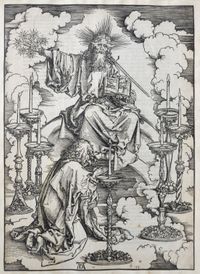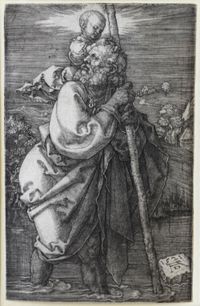One of the most enduring figures in art history, German artist Albrecht Dürer significantly shaped the development of illustration and art in Northern Europe.
Read MoreReputed in particular for his prolific output of woodcuts and engravings, Dürer applied many Renaissance principles observed during his travels around Italy and wider Europe to printmaking in a way that revolutionised the medium. Works such as Young Hare (1502), Praying Hands (1508), and his numerous self-portraits have endured through centuries as icons of Northern Renaissance art.
Born in Nuremberg to a Hungarian goldsmith, Dürer initially trained as a painter, goldsmith, and woodcutter. He was an apprentice to the reputable painter Michael Wolgemut from 1486 to 1489, and, from 1490, Dürer spent several years travelling as a journeyman. Upon returning to his home city in 1494, Dürer married Agnes Frey, and in the following year he opened a workshop. At the time, Nuremberg was a wealthy trade centre and a significant region to the Holy Roman Empire; during this period, Dürer began producing high quality prints and published The Apocalypse in 1498—a book containing 14 woodcuts to accompany the Book of Revelation.
In the late 1490s, Dürer travelled to northern Italy, where he was influenced by the works of artists including Giovanni Bellini and Andrea Mantegna. Around this period, Dürer also spent time studying mathematics, geometry, Latin, and literature. His self-portraits of the late 1490s reflect an increasing engagement with Renaissance ideas and innovations in portraiture.
Dürer returned to Italy in 1505, where he stayed for several years. The years between 1507 and 1512 saw the artist further embracing Renaissance ideas and principles such as chiaroscuro, moving away from lines in favour of softer, subtler tonal variations. He produced paintings and numerous woodcut series including Life of the Virgin (1511) and the Great Passion (1511). In 1509, Dürer was appointed to the Great Council of Nuremberg, and he purchased a house that would later become the Albrecht Dürer's House museum.
Albrecht Dürer's prolific and innovative use of printmaking techniques saw him gain attention amongst humanist scholars and the educated elite. His close friend Willibald Pirckheimer advised Dürer on developments of the Italian Renaissance and suggested subjects for his works that would have broader appeal. Print was Dürer's favoured medium, partly for its comparative profitability to painting and its ability to be more readily and widely disseminated across Europe—with paintings usually limited to private collections in select cities.
Dürer's woodcuts such as Saint Jerome (1492) and Hercules (c. 1496) tended towards a more Gothic style, while his engravings reflected the influence of Italian Renaissance principles. Adam and Eve (1504), St Jerome in the Wilderness (1512), and Melencolia I (1514) are some of many engravings by Dürer that employ his distinct method of crosshatching and fine lines to create a sense of tone and dimension more similar to painting than traditional woodcuts. His skilled draughtsmanship paired with a sophisticated use of iconography elevated Dürer's reputation and the broader appeal of the print medium. Dürer's reputation as a printmaker informed the Holy Roman Emperor Maximilian I's conception of the Triumphal Arch (1515–1517), a monumental woodcut print commissioned by the emperor of which Dürer was the chief designer.
Dürer's drawings span a broad range of subjects, including portraits, Biblical narratives, drapery, costumes, and hands. His drawings were executed in pencil, ink, or silverpoint. He also produced watercolour studies of landscapes, animals, and nature. The Castle at Trento (1495) demonstrates the artist's skilled rendering of architecture in watercolours, while the pen-and-ink drawing Praying Hands (1508) shows a lifelike rendering of tone and proportion.
Dürer demonstrated sophisticated draughtsmanship skills from an early age, exemplified in his Self-portrait (1484) in silverpoint, produced at age 13. The oldest known drawing by the artist and one of the oldest surviving self-portraits in European art history, the image illustrates Dürer's ability to translate tone and drapery in a naturalistic representation. The evolution of Dürer's portraiture can be appreciated in Self-portrait (1500), the last of Dürer's series of three painted self-portraits, which depicts an austere frontal view of the artist in a Christ-like representation.
Dürer's Young Hare (1502) is one of the artist's most recognisable works. The observational painting in watercolour and bodycolour was revolutionary for its near-photographic rendering of texture, proportion, and light, with fine details such as whiskers, fur, and the reflection of light in the rabbit's eyes.
Though the Lutheran church generally frowned upon religious artworks, Dürer produced several religious paintings in his lifetime, as well as portraits of family members and other figures. Dürer also continued to sketch throughout his life, typically carrying a sketchbook on his many travels beyond Nuremberg, in which he would make observational drawings.
In his later life, Dürer published numerous writings on theory and science, including Treatise on Measurement (1525), Treatise on Fortification (1527), and the posthumously published Four Books on Human Proportion (1528).
Dürer's Nuremberg home, where he lived from 1509 until his death, later opened as a dedicated museum in the late 19th century. Albrecht Dürer's House remains open today with a rotating programme of exhibitions, period furnishings, and technical demonstrations.
Dürer's works are held in major institutional collections worldwide, including the British Museum, London; National Gallery, London; Museum of New Zealand Te Papa Tongarewa, Wellington; National Gallery of Canada, Ottawa; The Metropolitan Museum of Art, New York; Los Angeles County Museum of Art; The Albertina Museum, Vienna; Städel Museum, Frankfurt; Rijksmuseum, Amsterdam.
Recent exhibitions featuring works by Dürer include Seen in the Mirror: Things from the Cartin Collection, David Zwirner, New York (2021); and Corpus, Beck & Eggeling International Fine Art, Düsseldorf (2018).
Misong Kim | Ocula | 2022






